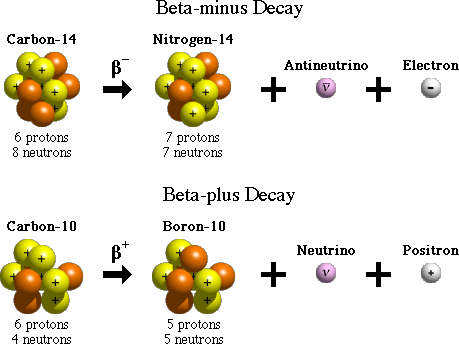Glossary
Beta Decay

Beta decay is one process that unstable atoms can use to become more stable. There are two types of beta decay, beta-minus and beta-plus.
During beta-minus decay, a neutron in an atom's nucleus turns into a proton, an electron and an antineutrino. The electron and antineutrino fly away from the nucleus, which now has one more proton than it started with. Since an atom gains a proton during beta-minus decay, it changes from one element to another. For example, after undergoing beta-minus decay, an atom of carbon (with 6 protons) becomes an atom of nitrogen (with 7 protons).
During beta-plus decay, a proton in an atom's nucleus turns into a neutron, a positron and a neutrino. The positron and neutrino fly away from the nucleus, which now has one less proton than it started with. Since an atom loses a proton during beta-plus decay, it changes from one element to another. For example, after undergoing beta-plus decay, an atom of carbon (with 6 protons) becomes an atom of boron (with 5 protons).
Although the numbers of protons and neutrons in an atom's nucleus change during beta decay, the total number of particles (protons + neutrons) remains the same.
Citation and linking information
For questions about this page, please contact Education Web Administrator.
